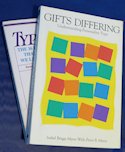
- About the MBTI
- Verify Your MBTI Type
- Personality Patterns
- MBTI Articles & Resources
- Article Directory for Educators & Students
- Books on Personality Types
- Emotional Intelligence & Personality Type
- Career Planning & MBTI
- MBTI Business Applications
- Lenore Thomson - Carl Jung Personality Type
- Site Map - Master Directory of All Articles
- MBTI Consultant Links
- Personality Type Workshops & Conferences
- Links to Other Type Websites
- Murder Mystery Business Theatre
- About Us
| 1 | 2 |
About the MBTI®
Understanding the MBTI ® and Personality Type
 About Peter Geyer |
The following article by Australian Peter Geyer provides a nice introduction to Myers-Briggs MBTI concepts and applications. Peter (INTP) is a consultant, researcher and writer in the field of C G Jung's theory of psychological types. He conducts MBTI Accreditation and Qualifying programs and presents internationally on a regular basis. Many more articles can be found on Peter's website. |
All About the MBTI®
Peter Geyer, INTP - Warrnambool, Australia
What is the MBTI?
The Myers-Briggs Type Indicator® (MBTI®) is a forced-choice personality inventory based on C.G.Jung's theory of Psychological Types. Its purpose is to make this comprehensive theory of personality practical and useful in people's lives.
Isabel Myers worked on the MBTI for nearly 40 years, until her death in 1980. The MBTI has been continually researched and was recently revised, with the publication of Form M in 1998.
The MBTI is an extremely reliable personality questionnaire. On average, 75% who take the MBTI report the same result on retake. For those with clear preference results, this can go up to 95%.
The MBTI and psychological type enables you to use a non-judgemental language to talk about some serious issues, both within an organisation and in counselling and helping people. Type theory is comprehensive, involving both nature and nurture: it is a systems theory and a stage theory, a dynamic way of representing who and what people are, and may become.
People who complete the MBTI are given a four letter code (e.g. ISTJ; ENFP etc.) as their results which, when verified, indicates their personality preferences as one of 16 Types.
The different type preferences lead to different ways of living and working, taking in information and making decisions. They describe different, effective approaches to working and learning styles and methods, managing, leading, coaching and teaching as well as general communication, teamwork, relationships, counselling etc.
Because the MBTI is based on a comprehensive and coherent theory of personality, applications can be found in almost anything which involves people e.g. communication, leadership, change management, team building, planning, marketing, writing, counselling, personal development, career planning, teaching and learning and so on.
The MBTI is not designed as a clinical inventory. All 16 types are considered valuable and normal, each with their own strengths and weaknesses and contributions to make to society and the workplace.
What are Type Preferences?
Type preferences are easy to understand, but also contain a lot of depth.
C.G.Jung, one of the pioneers of psychology, developed his theory of types as a means of accounting for differences in the way people take in information and make decisions. The theory remained a cornerstone of his thought and practice over many decades. His work was studied by Briggs and Myers who produced, the MBTI. They considered, broadly in line with Jung, that people had innate preferences for either:
-
Extraversion or Introversion i.e. whether people gained their personal energy from the outer world of people, things and action, or the inner world of thoughts, ideas and concepts.
As an example, people preferring Extraversion tend to enjoy being with large groups of people and prefer to act rather than reflect, while people preferring Introversion tend to enjoy quieter activities and to reflect before acting.
These concepts are much more complex than this simple example.
It seems that there are more Extraverts than Introverts in Australian society, but the difference is not great.
Extraverts tend to predominate in marketing and entrepreneurial spheres, while Introverts predominate in professions such as medicine and law, also politics.
The MBTI identifies Extraversion with E, Introversion with I. -
Sensing or Intuition i.e. whether people pay attention to their 5 senses, seeing the world as it is, from the standpoint of facts, or whether they are more interested in interpreting or applying meaning to what they see before them.
As an example, people preferring Sensing can be seen as practical and down to earth, relying on either past experience or what they see in the moment, while people preferring Intuition can be seen as visionaries or idealists, more interested in the future, or some timeless principle.
These concepts are much more complex than this simple example.
There are considered to be three times as many people preferring Sensing than those preferring Intuition in Australian society.
Intuitives outnumber Sensing people quite comfortably in academic institutions, particularly in post-graduate work, as well as in the arts in general, counselling and consulting. Sensing people predominate in teaching, small business, banking, law enforcement, sports etc., and are often attracted to work in large organisations.
The MBTI identifies Sensing S, Intuition with N. -
Thinking or Feeling i.e. whether a person prefers to make decisions based on an objective non-personal assessment, or based on subjective personal values. Both these processes are considered rational i.e. there's an order to either process.
Thinking judgement can be incorrectly associated with the intellect, or intelligence, while Feeling judgement can often be incorrectly confused with emotion, which is not an ordered process.
As an example, people preferring Thinking judgement may seek conceptual or factual clarity in a dispute, seeking to identify objective principles, whereas a person preferring Feeling may seek harmony or collaboration in the same dispute, seeking to bring the principals in the dispute together according to their personal values.
These concepts are much more complex than this simple example.
There are considered to be roughly equal numbers of each preference in Australian society, with the difference being that more males than females prefer Thinking judgement and more females than males prefer Feeling judgement.
People preferring Thinking predominate in management, medicine and most aspects of the law, while people preferring Feeling predominate in counselling and many of the helping professions.
The management areas of corporate and government worlds, irrespective of gender, are overwhelmingly comprised of people preferring Thinking judgement. When a plan goes awry, it can often be because the subjective, personal element of decision making has not been factored in sufficiently.
The MBTI identifies Thinking judgement with T, Feeling judgement with F. -
Judgement or Perceiving i.e. how a person prefers to run their life. A person preferring Judging likes to make decisions and may want to be scheduled and ordered, driven by lists and timeframes and expecting the same of others, whereas a person preferring Perceiving may not make a decision until the last possible moment, preferring a more spontaneous approach to life and work and resisting closure until it's time.
These concepts are much more complex than this simple example.
There are considered to be slightly more people preferring Judging than Perceiving in Australian society.
People preferring Judgement generally predominate in management positions (whatever the organisation), teaching, banking and law enforcement, whereas people preferring Perceiving predominate in marketing, entrepreneurial activities and counselling.
The MBTI identifies Judgement with J, Perceiving with P.
> > Page 2 - MBTI Preferences, Skills, Development, Culture. Learn about:
- MBTI Preferences, Skills, Development, Culture
- MBTI and Organisations.
- Practicality of the MBTI
- Why use the MBTI and not some other instrument or process?
® MBTI, Myers-Briggs, Meyers Briggs, and Myers-Briggs Type Indicator are registered trademarks or trademarks of the Myers-Briggs Type Indicator Trust in the United States and other countries (aka meyer briggs or myers briggs).
* While commonly referred to as the Myers Briggs Test or the MBTI test, the MBTI ® is not a test but a personality inventory or instrument in which there are no right or wrong answers.
© Published by Ross Reinhold & Reinhold Development 1997 - 2023
Privacy Policy About Us


